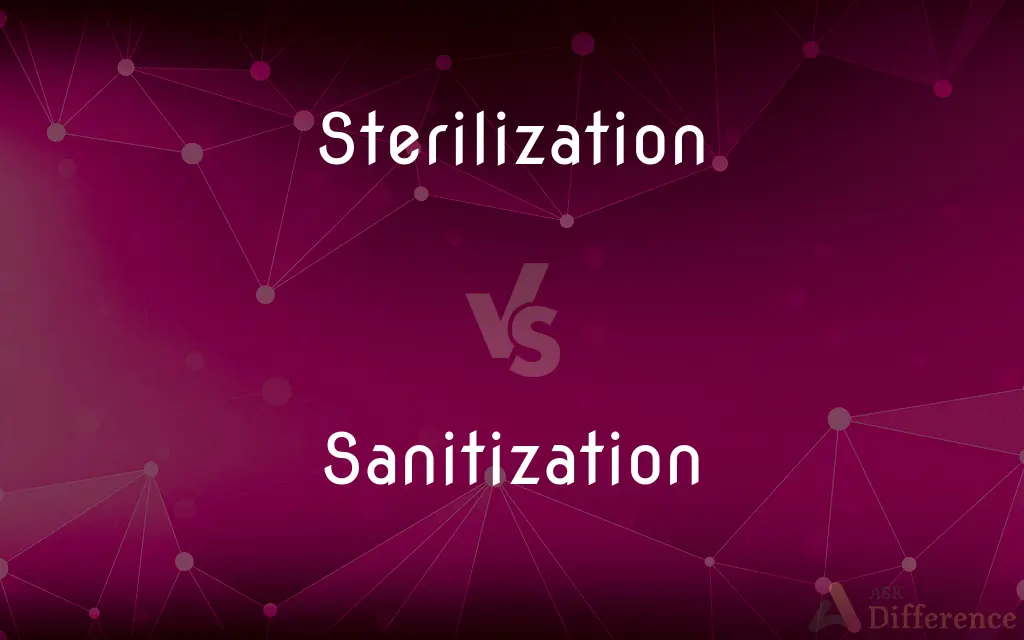Sterilization vs. Sanitization — What's the Difference?
By Fiza Rafique & Maham Liaqat — Updated on April 23, 2024
Sterilization eliminates all forms of microbial life including spores, whereas sanitization reduces bacteria to safe levels as judged by public health standards.

Difference Between Sterilization and Sanitization
Table of Contents
ADVERTISEMENT
Key Differences
Sterilization involves processes that destroy or eliminate all forms of microbial life, including bacteria, viruses, fungi, and spores. This is typically achieved through methods like heat, chemicals, irradiation, or filtration. Sanitization, on the other hand, aims to reduce the number of bacteria to a safe level, not necessarily eliminating all microorganisms.
Methods used in sterilization, such as autoclaving, dry heat, or chemical sterilants, are more intense and thorough compared to sanitization methods. Sanitization might involve simpler processes like using diluted bleach solutions or other disinfectants that are less harsh and do not guarantee the destruction of all microbial life.
The application of sterilization is crucial in environments where absolute cleanliness is essential, such as in hospitals, laboratories, and food processing plants where sterile conditions are required. Sanitization is more common in everyday environments, such as in restaurants, schools, and homes, where reducing microbial presence to safe levels is sufficient.
Regulatory standards for sterilization are stringent and specific, depending on the industry and the objects being sterilized. In contrast, sanitization standards can vary widely but generally align with public health requirements, focusing on achieving a level of cleanliness that is considered safe by health authorities.
The choice between sterilization and sanitization often depends on the level of microbial cleanliness required. Sterilization is necessary when there is a need to completely eliminate all risk of infection or contamination, whereas sanitization is adequate for general upkeep and routine cleaning where lower risks are involved.
ADVERTISEMENT
Comparison Chart
Objective
Eliminate all microbial life
Reduce bacteria to safe levels
Methods
Autoclaving, dry heat, chemical sterilants, irradiation
Diluted bleach, alcohol solutions, other disinfectants
Applications
Hospitals, labs, food processing
Restaurants, schools, homes
Regulatory Standards
Very strict and specific
Varying, aligned with public health standards
Outcome
Sterile environment, no microbes
Environment with reduced microbial load, not sterile
Compare with Definitions
Sterilization
Results in a sterile environment.
Sterilization of a lab bench is necessary before tissue culture experiments.
Sanitization
Common in everyday environments.
Sanitization protocols are critical in school cleanliness.
Sterilization
Completely removes all microbial life.
Autoclaving surgical instruments ensures their sterilization.
Sanitization
Reduces microbes to safe levels.
Daily sanitization of kitchen surfaces prevents foodborne illnesses.
Sterilization
Utilizes high heat or chemicals.
Dry heat sterilization is used for materials that can withstand high temperatures.
Sanitization
Uses milder chemicals or heat.
Sanitizing a baby's bottle can be done using a mild detergent and warm water.
Sterilization
Often used in critical medical and lab settings.
Sterilization is essential for any tools entering the human body during surgery.
Sanitization
Aims for public health safety.
Regular sanitization of public restrooms curbs the spread of infections.
Sterilization
Involves rigorous processes.
Chemical sterilization involves exposing items to sterilant gases.
Sanitization
Ensures general hygiene.
Hand sanitizers help maintain personal hygiene when soap and water are unavailable.
Sterilization
The process of making something free from bacteria or other living microorganisms
The food processing plant has undergone three sterilizations supervised by a microbiologist
Disinfection and sterilization of surgical equipment
Sanitization
To make sanitary, as by cleaning or disinfecting.
Sterilization
Surgery to make a person or animal unable to produce offspring
She had three children and had undergone sterilization
In the years preceding the case, the number of sterilizations performed there rose dramatically
Sanitization
To make more acceptable by removing unpleasant or offensive features from
Sanitized the language in adapting the novel for television.
Sterilization
To make free from live bacteria or other microorganisms.
Sanitization
The act of sanitizing something.
Sterilization
To eliminate the ability of a person or animal to produce offspring, as by altering or removing the reproductive organs.
Sanitization
The process of editing a security-classified document in order to reduce its classification level.
Sterilization
To make incapable of bearing fruit or germinating.
Sanitization
Making something sanitary (free of germs) as by sterilizing
Sterilization
To render (land) unfruitful.
Sterilization
(Economics) To place (gold) in safekeeping so as not to affect the supply of money or credit.
Sterilization
To make inoffensive or innocuous
Sterilized the terminology with euphemisms.
Sterilization
(uncountable) A procedure to permanently prevent an organism from reproducing.
Spaying a cat is a form of sterilization to limit the population growth.
Sterilization
(countable) An instance of a sterilization procedure.
The vet performed several sterilizations this week.
Sterilization
(uncountable) A monetary policy operation used to offset a foreign exchange intervention.
The Federal Reserve is responsible for foreign exchange sterilization.
Sterilization
The act or process of sterilizing, or rendering sterile; also, the state of being sterile.
Sterilization
The act of making an organism barren or infertile (unable to reproduce)
Sterilization
The procedure of making some object free of live bacteria or other microorganisms (usually by heat or chemical means)
Common Curiosities
What is sanitization?
Sanitization is the process of cleaning something to lower the number of germs to a safe level.
What is sterilization?
Sterilization is the process of removing or killing all forms of microbial life present.
Is sterilization the same as disinfection?
No, sterilization is more comprehensive, aiming to kill all microbes, while disinfection kills most but not all.
What are the risks of inadequate sterilization?
Inadequate sterilization can lead to infections and the spread of diseases, especially in medical settings.
Where is sterilization required?
Sterilization is required in medical, surgical, and laboratory environments to prevent infections.
What role does the FDA play in sterilization?
The FDA regulates the standards and methods of sterilization in medical settings.
Can sanitization kill all germs?
No, sanitization reduces the number of germs but does not kill all forms of microbial life.
What methods are used for sterilization?
Methods include autoclaving, dry heat, chemical sterilants, and irradiation.
How do restaurants ensure sanitization?
Restaurants follow health regulations, often using chemical agents to sanitize surfaces and utensils.
Can regular households perform sterilization?
Households typically perform sanitization, not sterilization, as the latter requires specialized equipment.
How does sanitization affect public health?
Effective sanitization reduces the incidence of diseases transmitted through environmental surfaces.
What is the difference in cost between sterilization and sanitization?
Sterilization generally involves more costly processes and equipment compared to sanitization.
What is a common method for sanitization?
Common methods include using diluted bleach or alcohol-based solutions.
What is the main difference between sterilization and sanitization?
The main difference is the extent of microbial removal; sterilization is complete removal, sanitization is reduction to safe levels.
Why is sterilization important in hospitals?
It prevents the spread of infections and maintains sterile conditions for patient safety.
Share Your Discovery

Previous Comparison
Concept vs. Theory
Next Comparison
Amish vs. MennoniteAuthor Spotlight
Written by
Fiza RafiqueFiza Rafique is a skilled content writer at AskDifference.com, where she meticulously refines and enhances written pieces. Drawing from her vast editorial expertise, Fiza ensures clarity, accuracy, and precision in every article. Passionate about language, she continually seeks to elevate the quality of content for readers worldwide.
Co-written by
Maham Liaqat















































